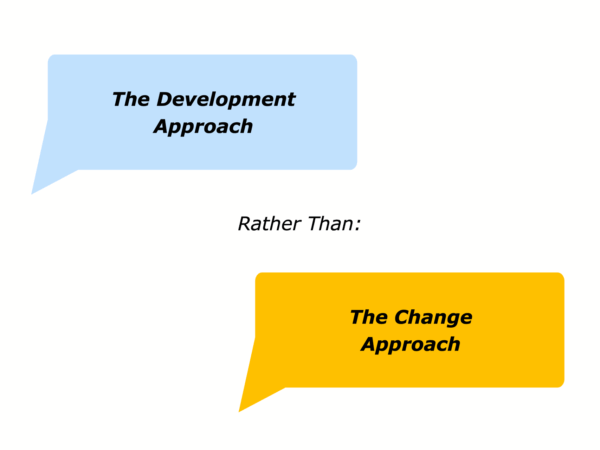
There are many ways to help people to grow. One approach is to encourage people to develop rather than change. The paradox is that, if people develop, others may see them change.
The development approach is also more user-friendly and effective. If you ask people if they want to develop, they will often say ‘Yes.’ It can be possible to help them to add to their repertoire of skills.
People who are urged to change may feel resentful or resist such calls. They may feel they are being told that they are failures. It can also be difficult for them to learn new habits.
The change approach can sometimes work if a person or a group feels they are in a critical situation. They may then feel motivated to achieve a different outcome, but this can still be challenging.
Bearing this in mind, let’s explore how the development approach can work in action.
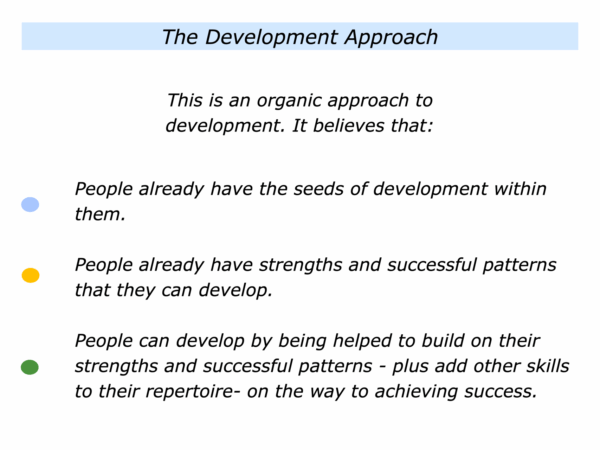
The development approach believes that many people already have inner strengths and successful patterns. They can build on these – plus add other skills to their repertoire – to achieve their picture of success.
People are emotional beings. They need to believe in their guts that following a certain strategy will achieve success. This is easier to do if they have followed some of these approaches successfully in the past.
Individuals can obviously learn things from outside, such as knowledge, models and tools. But the belief must come from within. People are more likely to sustain their motivation when following successful principles they believe will work in a situation.
People are often more open if they are offered specific things they can add to their repertoires. They then have more practical tools they can use to achieve their goals.
The Organic Development
Approach In Action
Let’s look at how this works in action. Here is an example from when I was doing mentoring work in a company. This focuses on the following theme.
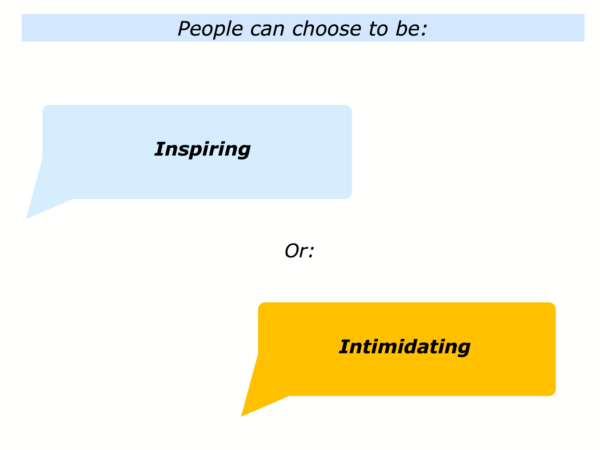
People who have strong personalities can choose to be inspiring or intimidating. This was the case with Tom, a top salesperson who wanted to become a Sales Director.
He was great with customers and always exceeded his targets. But in some interactions with colleagues he came across as dismissive. During meetings he talked across others and did his emails whilst they were talking.
Tom had a dynamic personality and could energise people, especially when talking about future possibilities for the company. On the other hand, he could also be destructive. Such swings in behaviour raised question marks about whether he could achieve his ambition to be Sales Director.
He had recently been turned down for such a role. The reasons given were that his behaviour sometimes upset peers and other colleagues in the company. He was told:
“There is no point in applying for such a role until you change this behaviour.”
Tom asked for help in tackling this challenge. After ten minutes or so, I gave him the following messages. This sounds rather blunt, but it seemed to resonate.
“You have a strong personality and can be very inspiring. On some occasions, however, you may also be intimidating. Bearing this in mind, you may face a choice about the possible roads you want to travel in your career.
“You are superb with customers. As far as I understand, you prepare properly for those meetings and make the customer feel the centre of your world.
“You listen to the customer, clarify their goals and then share ideas to help them achieve success. These are skills that, if you wish, you can also use to help your colleagues.
“Looking ahead in your career, you will always get a job in sales and make lots of money. If you want to be considered for a Sales Director role, however, you may need to explore how you can build a good reputation with colleagues.
“You already have the skills to make this happen, because you use these with customers. It is up to you to decide if you also want to use these with colleagues.
“Let me know if you want take this route. If so, we can work together and focus on how you can achieve success.”
Tom already had the required skills and used these constantly with customers. Choosing to encourage others in his company would involve him focusing on the following themes.
“Do I want to apply these same skills with colleagues? If so, how can I translate these into action? What will be the benefits – for myself and for my colleagues?
“Sometimes I get bored in internal meetings, so what can I do to manage my impatience? How can I recognise the triggers that lead to me behaving in ways that cause trouble? How can I manage these triggers?
“What are the actual words I want my colleagues to be saying about the way I behave towards them? What do I want my bosses to be saying? How can I do my best to ensure that people are saying these things?”
Tom chose to build on the skills he used with customers and apply these with colleagues. He developed these and, as a result, people said he had changed.
The key, however, was that Tom was channelling his personality in a way that created wins for his colleagues and company. He also learned how to manage the triggers that previously led to him flying off the handle.
Tom eventually moved into a Sales Director role. Bearing in mind his strengths, he focused on being the person who led the way and carried the banner. He complemented his style by hiring a superb orchestrator who could ensure the team delivered the goods.
He still set aside time to talk with individuals, however, and treated them like his internal customers. Tom gave them his full attention, focused on their aims and helped them to achieve their goals. This helped the individuals and the company to deliver success.
The work with Tom was based on a certain approach. As mentioned earlier, this helps people to channel their personality rather than change their personality.
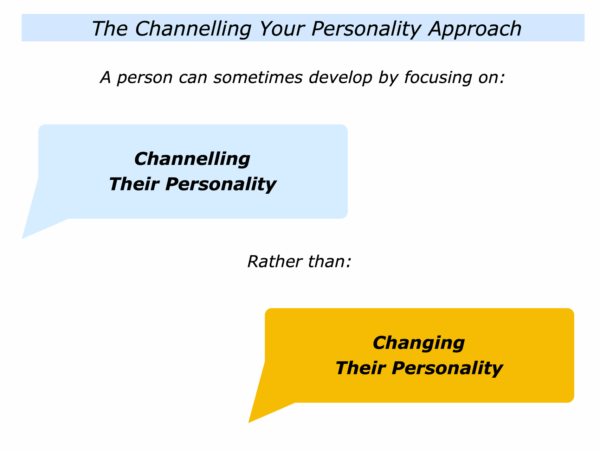
This is an approach I have found useful when working with people who may demonstrate certain characteristics. Here are some examples.
A person may be highly driven. They are energetic and achievement oriented but this can lead to them being impatient with others.
A person may be extremely caring. They are good at encouraging people but they may get exhausted by trying to help people who are takers.
A person may have OCD – Obsessive Compulsion Discipline. They may need to channel this into pursuing certain key strategies, however, rather than become mired in details.
A person may be highly sensitive and have mood swings. They may need to learn how to channel this sensitivity in ways that helps themselves and others.
A person may be a worrier. They may need to use the positive aspects of worrying – such as the part that aims to do superb work – and also develop the warrior side of their personality.
Looking at yourself, what are some of your personality traits? What do you see as the potentially positive parts of your personality? What are the parts that may sometimes be less positive?
Looking to the future, how can you build on the positive parts of your personality? How can you channel these in a way that helps yourself and other people? How can you manage the other parts of your personality?
If you wish, try tackling the exercise on this theme. This invites you to complete the following sentences.
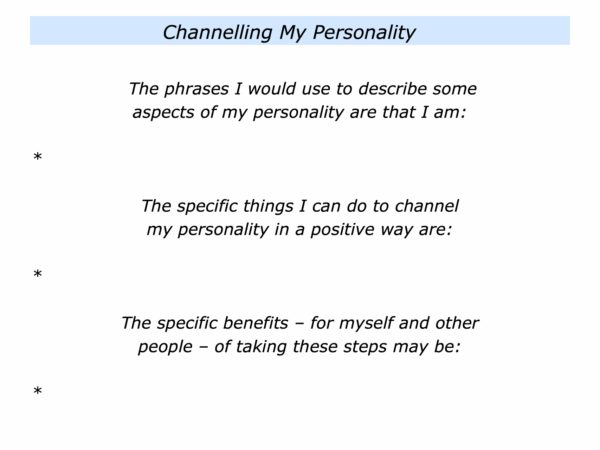
The Keep, Add And Do
Differently Approach
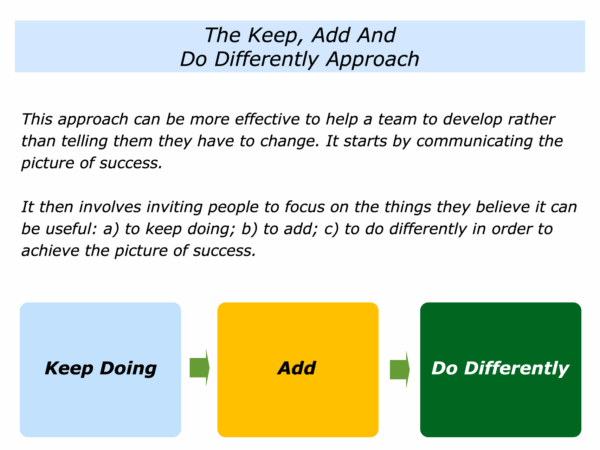
Imagine that you lead a team that wants to keep developing in order to stay ahead of the game. Here are some steps you can take to make this happen.
Setting The Scene
Gather people together and explain that you want to focus on how the team can continue to develop. One leader explained this in the following way.
“The purpose of this session is to look at how we can continue to shape a successful future. Looking ahead, these are the goals we want to achieve – the picture of success.
“I want you to come up with ideas about the specific things we can keep doing, add or do differently to help us to achieve these goals.
“Looking back, we have done outstanding work when acting as trusted advisors to clients. We have also worked well together when tackling certain crises.
“Looking ahead, we must continue to do what we do best. We also need to keep our internal stakeholders happy. The profit targets are mandatory, so we need to find ways to hit these targets.
“We also need to be proactive in keeping our stakeholders informed about our progress towards achieving the goals. This will stop them worrying.
“Many of our competitors are producing new applications that could put us out of business. We need to build on our strengths and develop ways to help our customers to achieve success.
“Bearing these things in mind, I am going to invite you to share how we can continue to do superb work in the future.”
Imagine that you have set the scene in your own way. You can then invite people to do the following exercise.
Give each person a pile of Post-it Notes. They are to each write ideas on the following themes. Here are some of the things that people come up with when doing these exercises.
Keep Doing
The specific things we want to take forward
from the past and keep doing in the future are:
To have the regular monthly breakfast meetings with the leadership team … To maintain the ethic of giving great customer service … To give input into how we can achieve the team’s goals.
To work remotely providing we deliver what is required … To do mentoring work with young people in schools … To have the profit share … To manage by outcomes rather than by tasks.
Add Or Do Differently
The specific things we want to add
or do differently in the future are:
To play more to our strengths as individuals … To produce success stories about our work as trusted advisors … To design the office so people can work in small groups and have spaces where they can work alone.
To bring in inspiring speakers from different fields … To separate the performance management and career development sessions … To have regular sessions where we contribute ideas to shaping a successful future.
Imagine you are doing this exercise with your team. Give people 15 minutes to write their ideas on Post-it Notes. They can then each go up in turn and put their ideas on the following flip charts.
You can then discuss the ideas. Clarify the ones that you and the team want to implement and translate these into a clear action plan.
Invite people to volunteer to be mission holders for the various projects. You can then provide them with the required support to deliver the goods and help the team to keep developing.
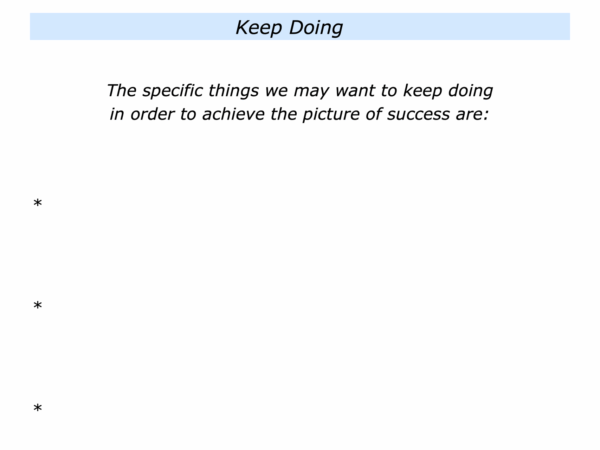
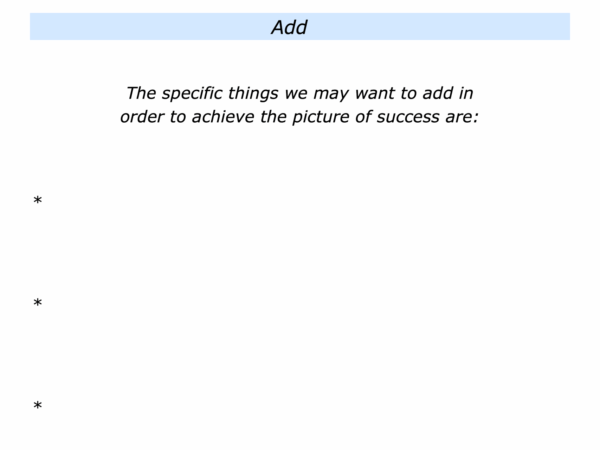
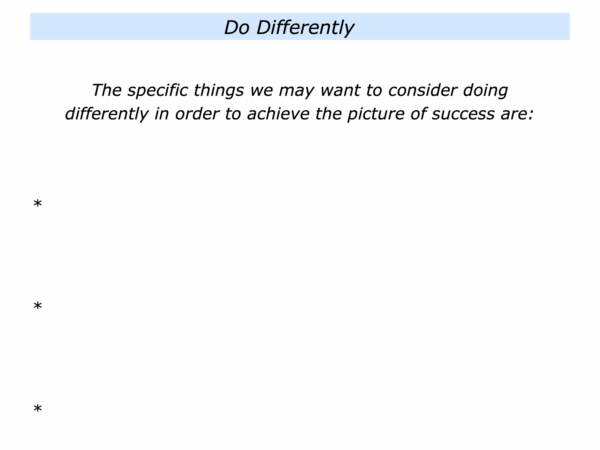
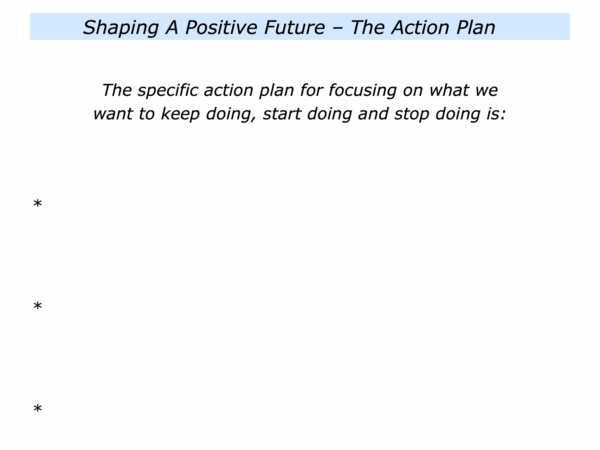


Leave a Reply